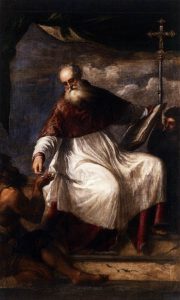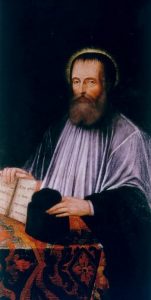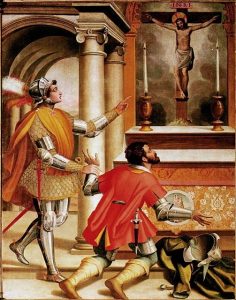 Saint John the Almsgiver
Saint John the Almsgiver
Patriarch of Alexandria (556-619)
Feast April 9
John the Almsgiver was born at Amathus. He was the son of Epiphanius, governor of Cyprus, and was of noble descent. In his youth John had had a vision of a beautiful maiden with a garland of olives on her head, who said that she was Compassion, the eldest daughter of the Great King. This had evidently made a deep impression on John’s mind, and, now that he had the opportunity of exercising benevolence on a large scale, he soon became widely known all over the East for his liberality towards the poor.
Saint John was married, but when his wife and two children died he considered it a call from God to lead a perfect life. He gave away all he possessed in alms, and became known throughout the East as the Almsgiver.
On the death of the Patriarch Theodore, the Alexandrians besought Emperor Phocas to appoint John his successor, which was accordingly done. One of the first steps he took was to make a list of several thousand needy persons, whom he took under his especial care. He always referred to the poor as his “lords and masters”, because of their mighty influence at the Court of the Most High. He assisted people of every class who were in need.
Saint John never spoke an idle word. He put out of the church those whom he saw talking, and forbade all detractors to enter his house.
He was a reformer who attacked simony and employed Sophronius (later Patriarch of Jerusalem) and John Moschus in his battle against the followers of Severus of Antioch. In order to fight heresy Saint John made improvements in religious education.
He also reorganized the system of weights and measures for the sake of the poor, and put a stop to corruption among the officials. He visited the hospitals three times every week, and freed a great many slaves.
On Wednesdays and Fridays of every week he sat on a bench before the church, to hear the complaints of the needy and aggrieved; he would not permit his servants to taste food until the wrongs were redressed. A man whom he had helped thanked him for his assistance one day, but he interrupted him, saying: My brother, I have not yet shed my blood for you, as Jesus Christ, my Saviour and my God, commands. On another occasion, after he gave his habit to a poor man who passed by, a person he did not know appeared immediately afterwards and gave him a sack containing a hundred gold pieces. After that, when he gave an alms, he always said, I am going to see whether Jesus Christ will fulfill His promise of giving me a hundredfold. The accomplished promise occurred so many times that he ceased to say these words, which were, in any case, for the benefit of those surrounding him.
The ministry of Vitalis of Gaza, a monk who worked among the prostitutes of the city, was a noteworthy episode of John’s reign. The patriarch was considered to have behaved with wisdom for not punishing this monk who was notorious for visiting the seedy part of town, and his judgment was vindicated only after the death of Vitalis when the story of the monk’s mission of mercy became known.
A merchant received from Saint John five pounds in gold to buy merchandise. Having suffered shipwreck and lost all, he had again recourse to the Almsgiver, who said, Some of your merchandise was ill-gotten; and he gave him ten pounds more. But at the next voyage the man lost his ship as well as its cargo. John then said, The ship was wrongfully acquired. Take fifteen pounds of gold, buy grain with it, and put it on one of my ships. This time the merchant was carried by the winds to England, where there was a famine. He sold the grain for its weight in tin, and on his return to Egypt he found the tin changed to fine silver.
A rich man presented him with a magnificent bed covering; he accepted it for one night, but then sold it, and disposed of the money in alms. The rich man “bought in” the article, and again presented it to John, with the same result. This was repeated several times; but John drily remarked: “We will see who tires first.”
Another instance of his piety was that he caused his own grave to be dug, but only partly so, and appointed a servant to come before him on all state occasions and say “My Lord, your tomb is unfinished; pray give orders for its completion, for you know not the hour when death may seize you.” When the Sassanids sacked Jerusalem in 614, John sent large supplies of food, wine, and money to the fleeing Christians. But eventually the Persians occupied Alexandria, and John himself in his old age was forced to flee to his native country, where he died. He had increased the number of churches in Alexandria from seven to seventy.
Saint John was solicited to come to Constantinople to give his blessing to the emperor Heraclius, about to go to war against pagan neighbors; but the great bishop was called to his reward during the voyage, and died while praying on his knees, in Cyprus around year 619, and his body was moved to Constantinople, then in 1249 to Venice. Another relic of him was sent by Sultan Bayezid II in 1489 to King Matthias Corvinus of Hungary. It was placed in the private Royal Chapel in Buda Castle which was dedicated to him. Now his body lies in the St. John the Merciful Chapel in the St. Martin’s Cathedral in Bratislava, Slovakia.
[1]”John the Merciful,” Wikipedia, [Online]. Available: https://en.wikipedia.org/wiki/John_the_Merciful. [Accessed 7 April 2017].
[2] “Saint John the Almsgiver – Lives of the Saints,” Magnificat, 24 February 2016. [Online]. Available:http://sanctoral.com/en/saints/saint_john_the_almsgiver.html. [Accessed 7 April 2017].
[3]”St. John the Almsgiver,” New Advent, 2012. [Online]. Available: http://www.newadvent.org/cathen/08486a.htm. [Accessed 7 April 2017].
 regory the Great
regory the Great Saint Romuald
Saint Romuald Saint Peter Nolasco
Saint Peter Nolasco




